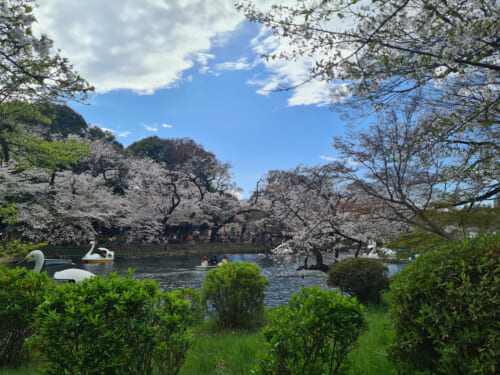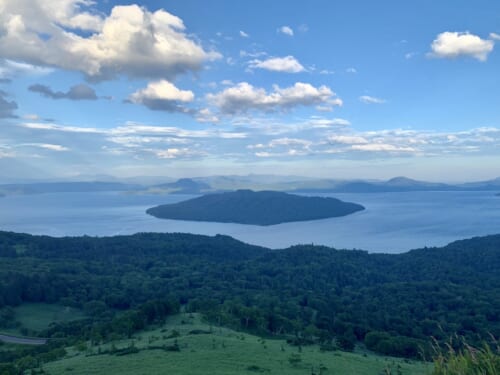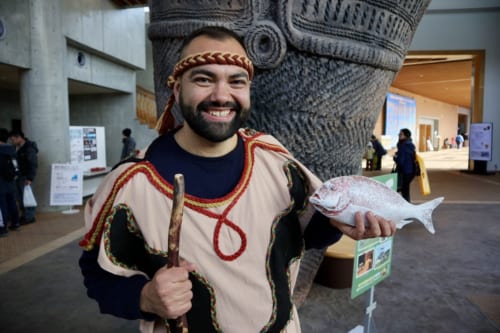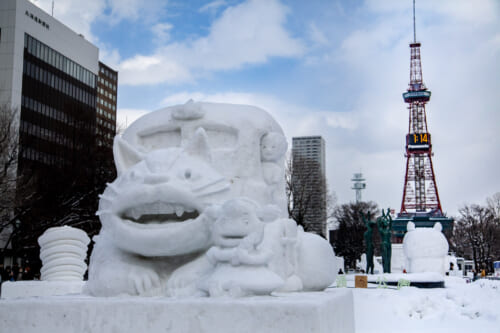This month in our My Japan series, Voyapon contributor Justin Randall walks us through a week in his life in Kitami, Hokkaido.
Someone once told me, that there isn’t anything in East Hokkaido, I think about those words often.
For me, East Hokkaido is all that there is as in my time in Japan, I’ve never lived elsewhere. From 2019, when I came over to Hokkaido’s furthest reaches as part of the JET program, to now Kitami where I work as a freelancer under the regional revitalization scheme.
East Hokkaido is my Japan, from its cold waters to towering mountain peaks, everything in between is inextricably linked to that age-old question, what is Japan?
Monday
A dozen fish dart above moss-covered stones, between clouds of mud, unfazed by my presence. “I’d have better luck kicking one than catching it,” I think to myself as I wade back to shore. I turn to look over the choppy waters of Lake Kussharo. As I gaze at the sunlit hills, eastern winds blow cold in my face.
Above me, autumn leaves smolder, soon to fall in the coming winter. As I prepare to leave, a fish jumps out of the water, it lingers in the shallows taunting me. I am reminded wholly of my inability as a fisherman but comforted that I’ll be back soon enough.
The drive back takes me down from Bihoro Pass through forests and farmland to my home in Kitami. Having only moved in here in August, after a stint farther east in Kushiro, I am still a newcomer. As a member of the regional revitalization corps, I’m tasked with promoting the city to eyes eager to experience East Hokkaido’s primeval nature.
Life in the corps is fresh compared to the stale office life typical of Japan. I work remotely, setting my own goals and schedules. Aiming to build my portfolio for full-time photojournalism at one point, much of my work is spent writing or traveling about taking pictures and learning about my town.
Work in East Hokkaido’s burgeoning tourism industry is always changing, with as many twists and turns as its mountain roads. I’m unsure where I’ll end up, but the road is mine.
Tuesday
Autumn rain brings low hazy clouds across auburn-colored foothills. I drive on slick roads, kicking water and leaves up at each turn. Today, I am hunting. In search of that perfect picture for our local tourism Instagram page. While not a downpour, the rain dissuades me from leaving my car, perhaps today’s fortunes aren’t so bright.
The engine of my kei van (a shortening of kei-jidosha, (軽自動車), which translates to English as “light automobile”) struggles up the slope. I crest the hill as the sun breaks through the clouds, bringing with it a beautiful rainbow. It illuminates a barn surrounded by grazing cattle. The rainbow shimmers as soft clouds pass through and it arcs across the valley crashing into an onion farm. I pull off to the side of the road and grab my camera and extra lenses. Rain taps my jacket as I exit to set up my tripod. But before I fire away, I let myself slow down and take in the quiet beauty of this new place.
Wednesday
The steel door swings open and loud mechanical noises drown out the headset in my ear. Our group walks down the catwalk hanging above the factory floor. This facility processes onions, Kitami’s chief export, for packaging. A conveyor system snakes below us, while workers pick out damaged onions. Most will be sent away to supermarkets across Japan. Others will be processed into sauces for Kitami’s other point of pride; yakiniku (grilled meat). With more yakiniku restaurants per capita than anywhere else in Hokkaido, today’s tour is about discovering the supply chain from farm to table, I’m excited about the latter.
Following our tour of the factory, our group made up of students, teachers, and workers from an array of backgrounds heads off to enjoy yakiniku at a local winery. A few workers from Myanmar share a conversation about our homes and how our lives drew us to Kitami.
A town built on meats and greens isn’t the most eye-catching branding in the hyper-competitive age of over-tourism. But what that simplicity does convey is resounding, a place not attempting to be something it isn’t. Kitami’s familiarity invokes nostalgia rooted in the catholic human experience of good food and company.
Thursday
In a conference room on the second floor of the Tourism and Culture Center in Teshikaga, dozens of people file in and take their seats. Today’s seminar reflects on the lessons learned since the Adventure Travel World Summit held in Sapporo in 2023. At the heart of the current movement is weaving stories into the adventure sought by many in Hokkaido. It isn’t enough to be in nature, companies must provide experiences which enroll participants into the story.
The first speak, Mr. Kikuchi, of Hokkaido Treasure Island, makes a quip catching me off guard, “There aren’t many Justin’s,” he chuckles as my ears turn beet red and I sheepishly smile back. East Hokkaido while abundant in places to see, delicious cuisine, and cultural oddities mysterious to even the most ventured traveler lacks in guides proficient in English.
I think about my role and how I can involve myself in the rising tides of tourism in the east. One of the greatest things about my current work is the permission to source income wherever. I suppose an English school side hustle might kick off earlier than planned.
Friday
The Tokoro Forest of Remains is as quiet as it was millennia ago. Thatch huts collect this year’s first snow; their tanned straw roofs peek from under dirty white snowpack. A bird breaks the morning silence, and my coworker furiously looks for it to snap a picture. We wait to depart on a monitor tour of Okhotsk culture ruins.
A predecessor to the Ainu, the Ohotsk was a hunter-gathering tribe spread across the Sea of Okhotsk north of Hokkaido. All that remains of their influence are burial mounds and the eroded pit dwellings. The Okhotsk region looks back in time for insight into how to best attract tourists to an often overlooked area of Hokkaido. Known as the Okhotsk Ruins Highway project, a corridor of ruins that reaches from the hills of Engaru to the rocky coasts of Monbestu, Kitami, and Abashiri. Balancing cultural tourism with the culinary and natural, it aims to narrate a story long untold. I’m tasked with taking photos and offering feedback to the organizers, my third monitor tour in as many months.
Light breaks through the trees casting long shadows on the ground and a deer yelps in the forest now aware of my invasion. I check my watch, time to head off to the start of the tour.
Saturday
Pain erupts as I slide down the ice holding a heavy curling stone. Compliments shower me from the group on my form but I am barely holding it in, I definitely should have put more into that pre-game stretch. I launch the stone and it flies down the ice, I pay it no mind focused only on determining if I’ve pulled a muscle. I shuffle off to the side and grab my camera.
The Argo Graphic Curling Hall located near Kitami Station is full of people today. Our group is sponsored by the local tourism association, offering people a chance to give curling a try and is open to foreigners as well! While some participants first played in school others are fresh to the sport. Curling, a local past time in Kitami, picked up interest over the years in large part to the homegrown team’s success at the Winter Olympics.
Sunday
In the distance, Shari’s jagged snowcapped peaks stand bold in the clear blue sky. Along the horizon, Mount Mokoto arched top has yet to receive snow, but it soon will. Further the south, Mount Oakan and Mount Meakan rise at the edge of my vision. I walk up the path to my favorite co-working space to, WorkingSpace Kiten, which offers a panoramic view of mountains and farmland; heaven and earth.
The staff, also members of the regional revitalization corps greet me, and we chat about our lives. All of them moved out to Hokkaido drawn to slowness of life and density of grand nature. Now they run the work space but also help in resettlement for other Japanese citizens eager for a change of pace, considering the beauty of the area and the charm of its people, I know they will find success.







No Comments yet!